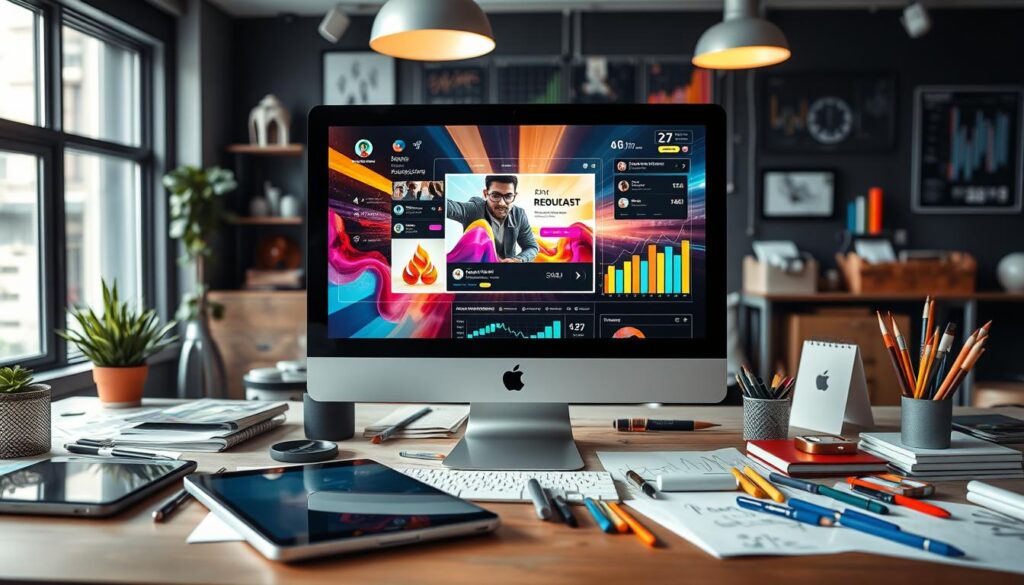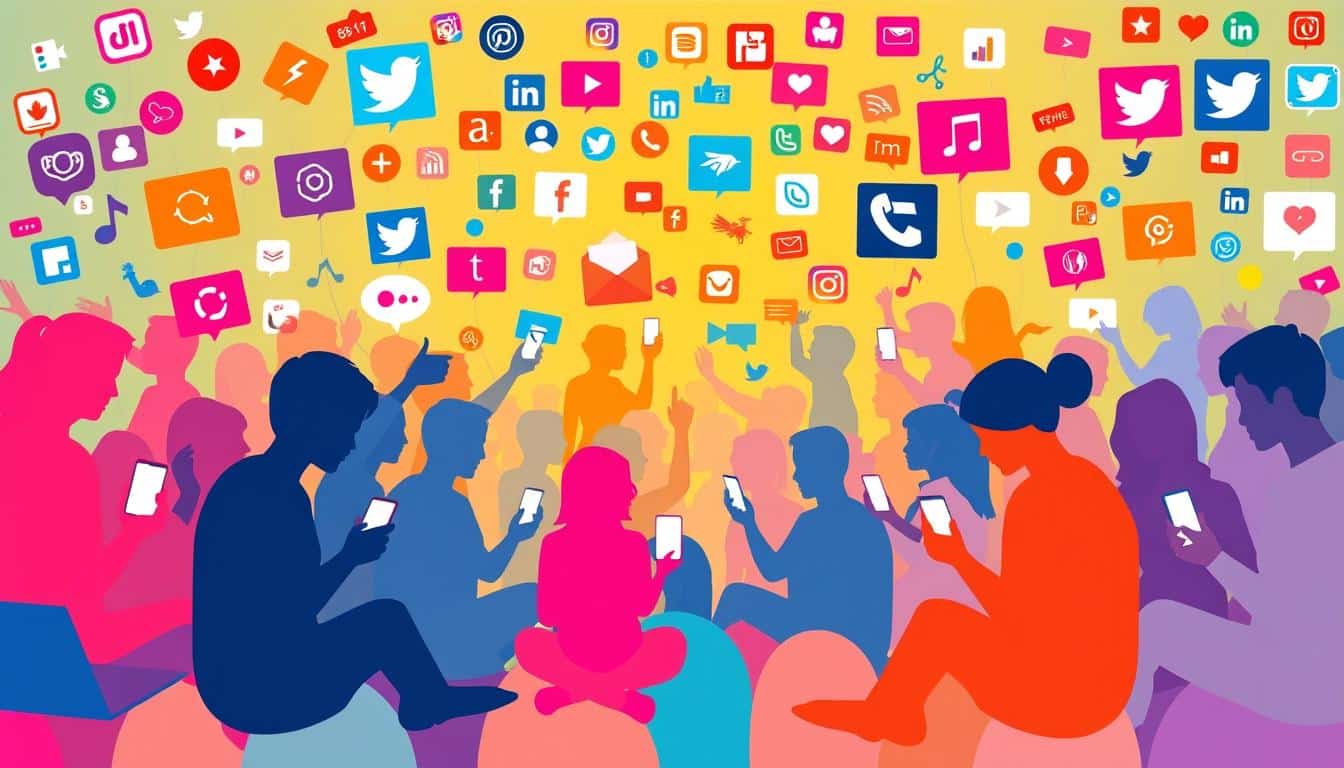Social media has changed the game in our digital world. Sites like Facebook, Instagram, Twitter, and TikTok have changed how we talk to each other. Now, social media is more than just a way to chat. It’s a strong tool for marketing and building brands, where influencers can really make a difference.
To do well in this fast-changing world, you need to get good at social media influencing. This article will share tips and tricks to boost your social media marketing. By using these strategies, adding visuals, and looking at data, you can connect with your audience, grow your brand, and see real success.
Key Takeaways
- Social media has transformed into a multifaceted platform, serving as a digital storefront, customer service desk, and community hub.
- Understanding your target audience is crucial for crafting effective social media strategies across different platforms.
- Leveraging social listening tools and analyzing platform-specific metrics can provide valuable insights to refine your content and targeting.
- Integrating customer data platforms (CDPs) can help you create comprehensive customer profiles and deliver personalized experiences.
- Consistent, engaging, and authentic content is key to building a strong social media presence and fostering connections with your audience.
Understand Your Audience Inside Out
Knowing your target audience well is key to making great social media plans. Look into their demographics, interests, and how they act online. This helps you make content that really speaks to them. Use social listening tools to keep an eye on what people say about your brand and competitors. Also, check out how people interact with your content on different platforms.
Leverage Social Listening Tools
Social listening tools help you see what’s being said about your brand and industry. They show you what your audience likes and dislikes. Use this info to shape your content, messages, and products.
Analyze Platform-Specific Metrics
Every social media site has its own stats that tell you about your audience. Look at things like how many people see your posts and how they interact with them. This helps you figure out what content works best and where your audience hangs out.
Create Customer 360s with a CDP
Use a Customer Data Platform (CDP) to get a full picture of your audience. It combines data from websites, social media, and purchases. This gives you detailed profiles that show who your audience is and what they like. It helps you tailor your messages and experiences to them.
| Metric | Benefit |
|---|---|
| Audience Demographics | Understand your audience’s age, gender, location, and other key demographics to tailor your content and messaging. |
| Interests and Preferences | Identify your audience’s passions, hobbies, and pain points to create content that resonates with them. |
| Online Behavior | Analyze your audience’s browsing habits, social media activity, and purchasing patterns to optimize your marketing strategy. |
By really getting to know your audience, you can make content that really speaks to them. This can make your followers more loyal and increase sales.
Create Compelling Content for Social Media Marketing

In the fast-paced world of social media, making engaging content is key to success. You need to connect with your audience, whether they’re Gen Z or millennials. Use the right platforms and share your content in different ways. Also, give special deals to your followers to build a strong bond and encourage them to buy.
Prioritize Relevant Platforms
Finding the right social media platforms is crucial. For example, fashion brands do well on Instagram and TikTok because of their visual appeal. On the other hand, B2B companies might do better on LinkedIn, where they can share their knowledge and connect with others in their field.
Repurpose Content Across Platforms
It’s important to make your content reach more people. By sharing your content on different platforms, you can get your message out to more people. A blog post can become a series of short videos or infographics, fitting different platforms and tastes.
Offer Exclusive Discounts to Followers
Thanking your followers with special deals can strengthen your bond and boost sales. It creates a sense of community and loyalty. By offering these perks, you can use social media’s influence to improve your marketing.
| Content Format | Preferred Platforms | Key Metrics to Track |
|---|---|---|
| Short-form Video | TikTok, Instagram Reels | Reach, Engagement Rate, Conversion Rate |
| Static Images | Instagram, Facebook | Impressions, Engagement Rate, Click-through Rate |
| Long-form Content | LinkedIn, Blog | Shares, Comments, Dwell Time |
By focusing on the right platforms, sharing your content, and offering special deals, you can create a strong social media strategy. It will connect with your audience, encourage them to buy, and grow your brand’s influence on social media.
Harness the Power of Influencer Partnerships
In the world of social media marketing, influencer partnerships are a key tool. They help build brand awareness and drive engagement. By working with influencers who share your brand’s values, you can reach a dedicated audience.
Micro-influencers are especially valuable. They have high engagement rates and are cost-effective. These influencers can help you share your message with the right people.
To measure your influencer partnerships success, look at engagement metrics. These include likes, shares, comments, and clicks. They show how well your campaigns are doing and help you improve for better conversions.
Being authentic is key in influencer marketing. Younger people, like Millennials and Gen Z, prefer real content from influencers they know. It’s important to choose influencers who match your target audience for trust and credibility.
Brands often use Instagram (67%), YouTube (36%), TikTok (42%), Twitter (15%), and Facebook (43%) for influencer campaigns. Nano or micro influencers tend to have higher engagement rates, making them a smart choice.
When planning influencer partnerships, aim to spend 15% of your marketing budget on them. This way, you can effectively engage your audience, drive brand alignment, and increase conversions.
| Influencer Type | Followers | Engagement Rates | Cost-Effectiveness |
|---|---|---|---|
| Nano Influencers | 1K – 10K | High | Very High |
| Micro Influencers | 10K – 100K | High | High |
| Macro Influencers | 100K – 1M | Medium | Medium |
| Mega Influencers | 1M+ | Low | Low |
As Millennials and Gen Z’s influence grows, brands need to adapt. This demographic has a huge spending power of $360 billion. By engaging with them through influencer partnerships, brands can tap into a significant market.
“Authenticity is the new currency in the world of influencer marketing. Consumers crave genuine connections, and brands that can foster that trust through their influencer partnerships will reap the rewards.”
Social Media Influencing: Strategies and Techniques

In the world of social media, being real and open is key. People today want true connections with brands and influencers. By sharing real stories and being clear in your messages, you can gain trust and strong relationships with your followers.
Authenticity and Transparency
Being true to yourself is crucial. Share your real experiences and stories to connect with your audience. Being open about sponsored content or partnerships is also vital. This honesty will win you the trust and loyalty of your followers.
Engaging Content Creation
Creating content that is both valuable and fun is essential. Use different formats like blog posts and Instagram stories to keep things interesting. Encourage your followers to share their own content, like using a branded hashtag, to build a community around your brand.
Consistent Presence
Posting regularly is important to stay visible and show your brand’s identity. Consistent posting keeps you in your audience’s mind and shows your commitment. Also, try interactive content like polls and challenges to engage more with your followers.
By focusing on being real, creating engaging content, and posting regularly, you can become a trusted influencer. This will help your brand achieve its goals.
“Authentic content and transparent communication are the keys to building a loyal following on social media.”
Optimize Paid Social Advertising

In today’s digital world, paid social ads are key for influencers and brands. They help you reach more people, target the right audience, and see real results. With retargeting, interest-based targeting, and ad formats, you can change the game for your social media influence.
Retargeting and Interest-Based Targeting
Retargeting helps you connect with people who’ve shown interest in your stuff. Serving them ads can push them to buy. Use interest-based targeting to find new people like your current customers. This combo can really boost your return on ad spend (ROAS).
Ad Format Selection
Picking the right ad format is key to grabbing your audience’s attention. Video ads show your products in action and tell a story. Instagram Story ads offer a cool, visual experience. Try different formats to see what works best for your audience.
Continuous Testing and Optimization
Success in paid social ads comes from always testing and tweaking. Try new ad copy, visuals, calls-to-action (CTAs), and landing pages. Look at your campaign metrics like click-through rate (CTR) and conversion rate to see what’s working. Use this info to make your ads better and increase your ROAS.
| Metric | Benchmark |
|---|---|
| Effective Visuals | 56% of a brand’s sales from digital marketing |
| Instagram User Age Range (25-34) | 13.9% of Instagram users worldwide |
| Mobile Ad Spend Forecast (2028) | $255.77 Billion |
| TikTok Ad Revenue Forecast (2027) | $53 Billion |
Mastering paid social ads can take your social media influence to new heights. Use these strategies and keep tweaking your campaigns. This will help you stay ahead and get amazing results for your brand or clients.
Also Read : The Basics of Digital Marketing for Beginners
Conclusion
Mastering social media marketing is a continuous journey. It needs you to keep up with new social media trends and try different strategies. You also need to connect with your audience in a real way.
Start by setting clear goals and knowing who your audience is. Make content that grabs attention and post regularly. Talk to your audience, work with influencers, and check how well your efforts are doing. This way, you can make the most of social media and meet your business goals.
It’s important to be quick to adapt to new platform updates. This keeps your social media presence fresh and interesting to your audience. As user behavior on social media changes, you need to adjust your digital marketing plans. This helps boost brand awareness and gets you meaningful results.
Social media is great for building audience engagement and creating real connections. By embracing the ever-changing nature of social media, you can use it to grow your brand. This will help you reach your business goals.
FAQs
Q: What is a social media influencer?
A: A social media influencer is an individual who has the power to influence the purchasing decisions and opinions of others through their social media presence and content. They typically have a significant following on platforms like Instagram, YouTube, or TikTok.
Q: How can I use social media to become an influencer?
A: To become a social media influencer, you should identify your niche, create engaging content, and consistently post on your chosen social media platforms. It’s also important to interact with your audience and build a community around your content.
Q: What are the different types of influencers?
A: There are several types of influencers, including mega-influencers (celebrities with millions of followers), macro-influencers (influencers with hundreds of thousands of followers), micro-influencers (those with 1,000 to 100,000 followers), and nano-influencers (everyday people with a small but loyal following).
Q: What is influencer marketing?
A: Influencer marketing is a strategy where brands collaborate with social media influencers to promote their products or services. This approach leverages the influencer’s audience and credibility to reach potential customers effectively.
Q: How does social media influence people?
A: The influence of social media is significant as it shapes opinions, trends, and consumer behavior. Influencers can sway their followers’ decisions through authentic content, recommendations, and showcasing products in a relatable context.
Q: What is the impact of social media on the world?
A: The impact of social media on the world includes the ability to connect people, spread information quickly, and create social movements. It has transformed communication, marketing, and commerce, allowing for greater outreach and engagement.
Q: How can I analyze my social media presence?
A: You can use social media analytics tools to track engagement metrics, follower growth, and the performance of your social media posts. This data can help you understand what content resonates with your audience and how to improve your social media strategy.
Q: What are the advantages of social media for influencers?
A: The advantages of social media for influencers include the ability to reach a large audience, create brand partnerships, generate income through sponsorships, and build a personal brand. It also allows influencers to share their passions and connect with like-minded individuals.
Q: How does social proof play a role in social media influence?
A: Social proof is the phenomenon where people are more likely to trust and follow the actions of others. In the context of social media, when influencers showcase products or experiences, their followers often believe in the value of those products due to the influencer’s endorsement, enhancing the overall impact of social media marketing.
Q: What is social commerce and how does it relate to influencer marketing?
A: Social commerce is the integration of e-commerce with social media platforms, allowing users to purchase products directly through social media posts. Influencer marketing plays a significant role in social commerce as influencers promote products to their followers, driving traffic and sales through social media networks.
Source Links
- https://www.simondata.com/blog-posts/mastering-social-media-marketing-strategies
- https://www.supplyht.com/articles/105963-mastering-social-media-marketing-for-maximum-impact
- https://www.linkedin.com/pulse/5-social-media-lessons-inside-out-can-teach-us-kundai-mangwende
- https://blog.hubspot.com/service/know-your-audience
- https://sproutsocial.com/insights/social-media-content-strategy/
